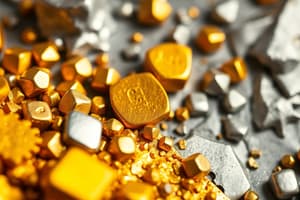Podcast
Questions and Answers
What defines an alloy?
What defines an alloy?
- Mixture of metals with no chemical bonding
- Homogeneous mixture of metals with random atom distribution (correct)
- Blend of non-metallic elements
- Combination of metal and non-metal elements
Why are alloys formed by transition metals readily?
Why are alloys formed by transition metals readily?
- They have high reactivity
- They have random atomic distribution
- They possess non-metallic characteristics
- They have similar metallic radii (correct)
What is disproportionation in terms of oxidation states?
What is disproportionation in terms of oxidation states?
- Reduction of an element to a lower oxidation state
- Increase in the stability of an oxidation state
- Simultaneous oxidation and reduction of an element (correct)
- Transition of an element to an unstable oxidation state
Which elements are commonly used in ferrous alloys?
Which elements are commonly used in ferrous alloys?
What are the main components of brass alloy?
What are the main components of brass alloy?
How is the stability of the Cu ion affected in aqueous solutions?
How is the stability of the Cu ion affected in aqueous solutions?
Which of the following best describes the difference between the chemistry of actinoids and lanthanoids?
Which of the following best describes the difference between the chemistry of actinoids and lanthanoids?
What is the last element in the actinoid series?
What is the last element in the actinoid series?
Why is the chemistry of the actinoid elements said to be less smooth than that of the lanthanoids?
Why is the chemistry of the actinoid elements said to be less smooth than that of the lanthanoids?
Which member of the lanthanoid series exhibits both +2 and +4 oxidation states?
Which member of the lanthanoid series exhibits both +2 and +4 oxidation states?
What is a common application of bronze alloy?
What is a common application of bronze alloy?
Which transition metal exhibits the most stable +1 oxidation state in aqueous solutions?
Which transition metal exhibits the most stable +1 oxidation state in aqueous solutions?
Which of the following best explains the disproportionation reaction of copper(I) ion in aqueous solution?
Which of the following best explains the disproportionation reaction of copper(I) ion in aqueous solution?
Which of the following transition metal compounds is used as a catalyst in the Haber process for ammonia production?
Which of the following transition metal compounds is used as a catalyst in the Haber process for ammonia production?
What is the primary reason for the lanthanoid contraction being more significant than the actinoid contraction?
What is the primary reason for the lanthanoid contraction being more significant than the actinoid contraction?
Which of the following oxides is commonly used as a pigment in the industry?
Which of the following oxides is commonly used as a pigment in the industry?
Which of the following alloys is commonly referred to as 'bronze'?
Which of the following alloys is commonly referred to as 'bronze'?
Which of the following oxoanions is used in dry battery cells?
Which of the following oxoanions is used in dry battery cells?
Flashcards are hidden until you start studying
Study Notes
Definition and Formation of Alloys
- An alloy is a mixture of two or more elements, where at least one is a metal, designed to enhance properties such as strength, corrosion resistance, and ductility.
- Alloys are readily formed by transition metals due to their ability to exhibit multiple oxidation states and the presence of unfilled d-orbitals, allowing for a variety of bonding configurations.
Disproportionation and Oxidation States
- Disproportionation is a chemical reaction in which a single species is transformed into two different products with varying oxidation states.
- An example of disproportionation involves copper(I) ions in solution, which can convert into copper(II) ions and elemental copper.
Ferrous Alloys and Their Components
- Commonly used elements in ferrous alloys include carbon, manganese, nickel, and chromium, which enhance strength and hardness.
- The main components of brass alloy are copper and zinc, providing a balance of strength and malleability.
Stability of Copper Ion
- The stability of the copper ion (Cu²⁺) in aqueous solutions is impacted by coordination with water molecules and ligands, influencing solubility and reactivity.
Chemistry of Actinoids vs. Lanthanoids
- Actinoids exhibit more complex chemistry compared to lanthanoids, attributed to greater variation in oxidation states and the involvement of f-electrons in bonding.
- The last element in the actinoid series is lawrencium (Lr), which can exhibit oxidation states varying from +3 to +4.
- Promethium (Pm) in the lanthanoid series is notable for exhibiting +2 and +4 oxidation states.
Applications and Stability of Alloys
- Bronze alloy, primarily composed of copper and tin, is widely used in sculptures, tools, and coins due to its durability and aesthetic qualities.
- The transition metal that displays the most stable +1 oxidation state in aqueous solutions is copper, particularly in its Cu⁺ form.
Reaction Mechanism and Catalysts
- The disproportionation reaction of copper(I) in aqueous solution leads to the formation of copper(II) and elemental copper, facilitated by the oxidizing conditions in the solution.
- Iron catalysts, particularly iron(III) oxide, are used in the Haber process for synthesizing ammonia from nitrogen and hydrogen.
Lanthanoid and Actinoid Contraction
- The lanthanoid contraction, caused by the ineffective shielding of nuclear charge by f-electrons, is more pronounced than the actinoid contraction due to the high effective nuclear charge in actinoids.
Pigments and Alloys
- Titanium dioxide (TiO₂) is commonly used as a pigment in the industrial sector due to its brightness and high refractive index.
- The term 'bronze' typically refers to a copper-tin alloy but can also encompass various other copper-based alloys.
Battery Components
- Manganese dioxide (MnO₂) oxoanions are commonly used in dry battery cells, enhancing electrochemical performance.
Studying That Suits You
Use AI to generate personalized quizzes and flashcards to suit your learning preferences.




